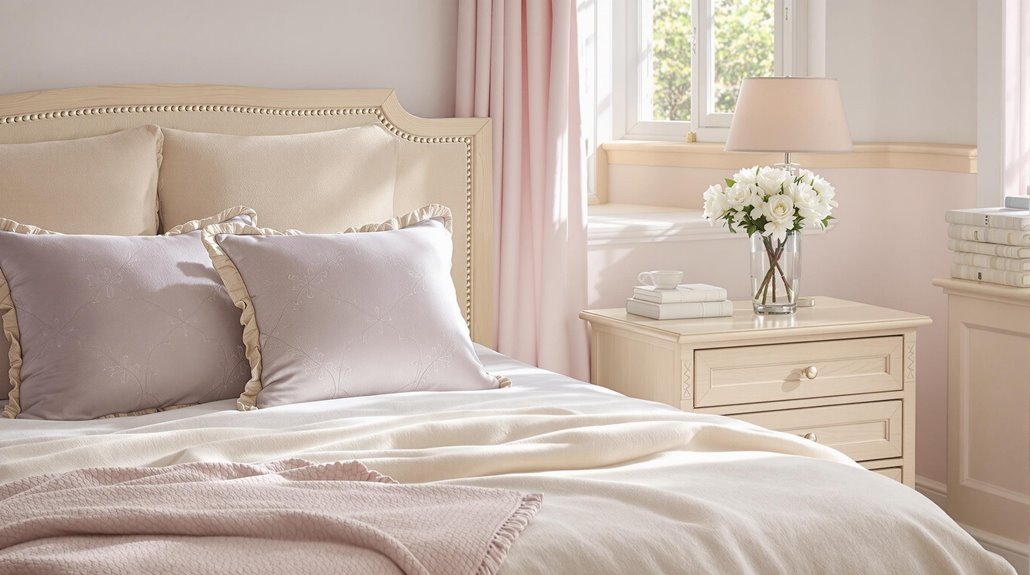The best color for bedroom furniture depends on desired mood and atmosphere. Calming blues and soothing greens promote tranquility, while gentle pinks and grays create a serene ambiance conducive to sleep. Neutral whites and creams reflect light, enhancing space and inviting relaxation. Earthy browns and taupes contribute to a warm, cozy environment. For added sophistication, deep purples evoke mental clarity and introspection. Selecting the right shade involves considering natural light and room size while balancing bold and neutral colors for visual appeal. Thoughtful color combinations can enhance the overall aesthetic, leading to a restful environment that supports well-being. Insights on strategic selections await further exploration.
Calming Blues
As blue hues envelop a bedroom, they not only evoke a sense of tranquility but also promote a restful atmosphere conducive to sleep. Scientifically proven to enhance comfort and happiness, blue is inherently associated with relaxation, making it an ideal choice for spaces designed for rest. Its calming properties can lower heart rate and blood pressure, further contributing to a de-stressing environment. Lighter shades of blue can create an illusion of expanded space, while darker blues foster intimacy. Versatile options, such as Atmospheric Blue and Bathe Blue, allow for creative combinations with natural color palettes, enhancing the room's calming effect. Therefore, incorporating blue into bedroom design facilitates an inviting and soothing retreat conducive to restorative sleep.
Soothing Greens
The gentle embrace of soothing greens in a bedroom creates an environment that mirrors the tranquility of nature. Associated with renewal and relaxation, green notably reduces anxiety and fosters peace, making it an ideal choice for sleep spaces. This color promotes a calm atmosphere, inviting restful sleep and harmonious vibes. Various shades, such as sage green, are particularly effective due to their calming qualities and association with growth. Green furniture can seamlessly integrate into diverse aesthetics, from modern to traditional. Pairing bold green pieces with neutral bedding provides a balanced look, while incorporating natural materials enhances breathability. Ultimately, the strategic use of green in bedroom decor can improve well-being and cultivate a serene environment conducive to relaxation.
Neutral Whites and Creams
Neutral whites and creams offer a timeless design appeal that complements various decor styles, making them an excellent choice for bedroom furniture. Their versatility allows for seamless color pairings, enhancing the overall aesthetic while creating a tranquil atmosphere that promotes relaxation. By reflecting natural light and providing a neutral backdrop, these shades not only make small spaces feel more expansive but also contribute to a soothing environment conducive to restful sleep.
Timeless Design Appeal
A palette of neutral whites and creams offers a timeless design appeal that enhances any bedroom. These hues create a versatile backdrop, allowing for seasonal decor changes while maintaining a calming, airy atmosphere. The simplicity of whites and creams facilitates the incorporation of various textures and patterns, from tufted headboards to layered linens, enriching the visual complexity of the space. Adding accents in silver, gold, or natural elements introduces sophistication and warmth, further enhancing the room's elegance. This adaptable color scheme complements diverse design styles, whether modern or traditional, and can accommodate any architectural features. Ultimately, neutral whites and creams provide a serene foundation, fostering a cohesive and inviting bedroom environment.
Versatile Color Pairings
Incorporating versatile color pairings with neutral whites and creams can considerably enhance the overall aesthetic of a bedroom. Neutral wall colors, such as grey, beige, and cream, create sophisticated backdrops that allow white furniture to stand out as a focal point. Grey walls exude elegance, while beige offers warmth that balances the brightness of white furnishings. Cream walls enhance natural light, creating a soothing environment. Each neutral tone has versatile undertones, enabling compatibility with various decorating styles; warm neutrals foster intimacy, while cool tones promote calmness. Additionally, accent walls in dramatic colors or softer shades can add depth to the design. Ultimately, the choice of neutral colors should reflect individual style and desired ambiance, enhancing the bedroom's overall appeal.
Enhancing Tranquil Atmosphere
While selecting colors for a bedroom, opting for whites and creams can greatly enhance the tranquil atmosphere, creating a serene retreat for relaxation. These neutral shades reflect natural light, fostering a bright and airy environment that makes even small spaces feel expansive. Utilizing soft tones such as Timeless or Vanilla Mist alongside creamy white walls and bedding amplifies this effect, contributing to a fresh and inviting ambiance. Additionally, creams and beiges are gentle on the eyes, promoting relaxation and a sense of warmth. To further enrich the decor, incorporating varied textures, such as plush rugs and natural wood accents, can enhance depth while maintaining a soothing atmosphere, ultimately leading to improved well-being and restful sleep.
Earthy Browns and Taupes
The harmonious blend of earthy browns and taupes creates a tranquil and inviting atmosphere in bedroom design. Rich and warm brown tones, particularly from wood furniture like mahogany bed frames and side tables, establish a cozy ambiance. These elements pair effectively with taupe walls, which serve as a versatile neutral backdrop, enhancing the richness of browns while maintaining an understated elegance. The calming effect of earthy browns promotes relaxation, making them ideal for bedrooms. Additionally, taupe's adaptability allows it to complement various decor styles, from rustic to modern. This combination not only creates depth through layered textures, such as soft linens and fluffy blankets, but also supports a timeless appeal that guarantees the design remains relevant across trends.
Gentle Pinks and Grays
Gentle pinks and grays create a serene and sophisticated atmosphere in bedroom design, making them an ideal choice for those seeking a calming retreat. Pink is associated with tenderness and calmness, often lowering heart rate and blood pressure to promote better sleep. Pastel pink, in particular, evokes tranquility without overwhelming the senses. When combined with gray, a neutral color that balances vibrancy, the result is a harmonious palette. For instance, pairing light pink walls with a dark gray headboard creates a chic aesthetic. Additionally, incorporating gray accents can enhance the overall design, allowing for various patterns and textures. Ultimately, gentle pinks and grays offer a versatile foundation for a restful bedroom environment, suitable for diverse styles and preferences.
Deep Purples and Luxurious Hues
Deep purples evoke a sense of elegance and sophistication, making them an attractive choice for bedroom furniture and decor. Their rich hues not only create a cozy and introspective atmosphere but also enhance the visual depth of the space, allowing for a harmonious blend of boldness and refinement. By carefully integrating these luxurious colors with complementary elements, one can achieve a well-balanced design that promotes relaxation and style.
Elegant Color Choices
While selecting colors for a bedroom, opting for deep purples can introduce an element of elegance and sophistication that elevates the entire space. Historically associated with royalty, these hues evoke a sense of luxury while simultaneously promoting calmness, essential for a restful environment. The versatility of deep purple allows for various moods, ranging from serene to dramatic, depending on the chosen shade. Complementary colors, such as gold or cream, enhance the luxurious appeal, while a monochromatic palette can add depth without monotony. Additionally, incorporating rich fabrics like velvet and intricate details, such as carved wood, can further amplify the opulent ambiance. Overall, deep purples provide a refined backdrop, fostering a sophisticated yet inviting atmosphere in the bedroom.
Cozy and Introspective Vibe
As homeowners seek to create a sanctuary for rest and reflection, the use of deep purples and luxurious hues can profoundly impact the atmosphere of a bedroom. These colors, particularly shades like deep plum and eggplant, are known for promoting mental clarity and physical relaxation, essential for enhancing sleep quality. Additionally, the sophistication associated with deep purples aligns with Vastu principles, fostering a calming environment. The psychological effects of these hues stimulate creative thinking while inviting introspection. To achieve a cozy vibe, pairing deep purples with luxurious textures—such as velvet pillows and silk sheets—can elevate the sensory experience. Consequently, incorporating deep purples not only enhances aesthetic appeal but also contributes to a harmonious and peaceful bedroom atmosphere.
Adding Depth to Spaces
A rich palette of deep purples can dramatically enhance the depth and sophistication of bedroom spaces. These hues, associated with mental clarity and relaxation, foster an environment conducive to better sleep. Darker shades like plum and eggplant evoke feelings of introspection and sensuality, aligning with Vastu principles that prioritize calmness. The luxurious ambiance created by these colors is further elevated when paired with gold accents and dark wood furniture, which contribute to a sense of grandeur. Incorporating textures such as velvet and silk enhances this opulence, while carefully selected lighting and textiles add visual allure. Balancing deep purples with softer shades or complementary colors creates a harmonious aesthetic, making them an ideal choice for bedroom furniture.
Choosing the Right Shade
How can you select the perfect shade for your bedroom furniture? Begin by considering color temperature and its effects on mood and ambiance. Warm colors, such as earth tones, create an intimate and cozy atmosphere, while cool colors, like blue and green, promote tranquility and relaxation. Neutral colors, including white and grey, offer versatility and can instill a sense of calm or luxury. Factor in natural light, room size, and the type of furniture when making your selection; dark hues can cozy larger spaces, whereas light shades can expand smaller ones. Ultimately, prioritize personal preference and test swatches to guarantee long-term satisfaction. The chosen shade should harmonize with your overall style, contributing to a restful environment conducive to sleep and well-being.
Combining Colors Effectively
When selecting colors for bedroom furniture, effective combinations can greatly enhance the overall atmosphere of the space. Balancing bold and neutral colors is essential; using vibrant shades as accents against a backdrop of whites or grays creates a harmonious visual appeal. Complementary colors add contrast while maintaining balance—dark frames can offset lighter walls, enriching the room's aesthetic. In addition, mixing earthy tones with pastel hues fosters a calming environment, especially when enhanced with natural materials. Integrating metal and wood accents introduces sophistication, as metals paired with neutrals and dark woods against lighter shades create depth. Ultimately, these strategies guarantee a cohesive, inviting bedroom that reflects personal style while promoting tranquility.

